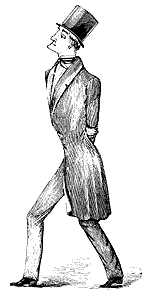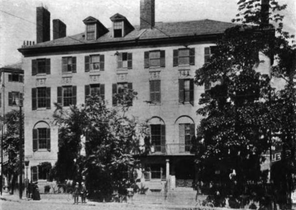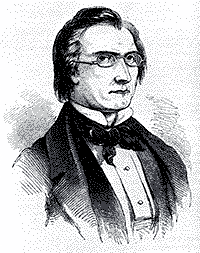George Parkman
| George Parkman | |
|---|---|
 George Parkman, "The Pedestrian" | |
| Born |
George Parkman February 19, 1790 Beacon Hill, Boston, Massachusetts, United States |
| Died |
November 23, 1849 (aged 59) Beacon Hill, Boston, Massachusetts, United States |
| Cause of death | murder |
| Nationality | United States |
| Occupation | physician, real estate developer, landlord |
| Known for | Parkman–Webster murder case |
| Parent(s) |
Samuel Parkman (father) |
| Relatives |
Elizabeth Willard Parkman (sister) |
George Parkman (February 19, 1790 – November 23, 1849), a Boston Brahmin and a member of one of Boston's richest families, was a prominent physician, businessman, and philanthropist, as well the victim in the sensationally gruesome Parkman–Webster murder case, which shook Boston in 1849–1850.
Family

Samuel Parkman (August 22, 1751 – June 11, 1824) and Sarah Rogers had five children: Elizabeth (1785), Francis (1788), George (1790), Samuel (1791), and Daniel (1794). Samuel Parkman had also had six children by his previous marriage to Sarah Shaw.[2] Samuel Parkman, George’s father and family patriarch, had bought up low-lying lands and income properties in Boston’s West End.[3] He also founded and was part owner of the towns of Parkman, Ohio and Parkman, Maine.[4][5] His sons from his first marriage oversaw the Ohio properties, while his second set of boys were responsible for the Maine parcel. Samuel’s daughters inherited wealth as well. The most notable was George’s sister Elizabeth Willard Parkman, whose spouse Robert Gould Shaw (1776 – 1853), grandfather of Robert Gould Shaw (October 10, 1837 – July 18, 1863, Union Army colonel during the American Civil War), grew his wife’s share of the fortune to become the senior partner in the most powerful commercial house in a city glutted with the proceeds of the China Trade.[6]
The eleven Parkman scions united in marriage with the Beacon Hill families of Blake, Cabot, Mason, Sturgis, Tilden, and Tuckerman. Of his eleven offspring, Samuel chose George as the one to administer the Parkman estate.[7]
Early life
George Parkman’s poor health as a youngster led him to want to study medicine. He entered the freshman class of Harvard University when he was only 15 years old, and delivered the "Salutory Oration" in 1809. Despite his assured wealth, a lecture by Benjamin Rush inspired him to take an interest in the terrible state of asylums for the mentally ill. He spent two years at the University of Aberdeen in Scotland obtaining his medical degree.[8] After returning to Boston, he traveled aboard the USS Constitution to Europe and was under the charge of a former Bostonian, Benjamin Thompson, who introduced him to the Minister of France, Joel Barlow. Barlow introduced him to many doctors in Paris. While there, he observed the pioneering and humane treatment methods of two famous French psychiatrists, Philippe Pinel and Étienne Esquirol. He studied at the Pitié-Salpêtrière Hospital for his graduate work. "My first knowledge of the Saltpêtrière, was with the high privilege of the guidance of its great physician, Pinel, and of his new illustrious associate, Esquirol. Pinel received me kindly, and inquired with much interest after Benjamin Rush, who had lately written his book on Diseases of the Mind," Parkman wrote from Paris.[9] That same interest helped to cement the relationship between Parkman and Pinel. The 70-year-old Pinel’s ideas impressed Parkman. Under great teachers like Pinel and Esquirol, Parkman practiced at the great Parisian Asylum, and learned the history and treatment of mental "diseases." At this time Parkman developed his own path of his career. He spent time in England studying with men of Science, as well.[10]
Parkman returned to the U.S. in 1813. The War of 1812 called for the service of young men and Parkman “received a commission as a surgeon in a regiment of the third brigade belonging to the first division of the Massachusetts militia.” He began in South Boston and simultaneously served as a physician to the poor with a desire to replicate the practices of Pinel and Esquirol.[11]
Parkman believed that psychiatric institutions should reflect a residence-like setting, where patients could enjoy hobbies and socializing and participating in household chores, as permitted. Parkman thought Pitié-Salpêtrière Hospital was a good model and talked to the faculty of Massachusetts General Hospital about having a lunatic hospital connected to it. In 1817, he wrote two papers, Remarks on Insanity and The Management of Lunatics in an effort to convince the trustees of the Massachusetts General Hospital that he could supervise an asylum they were considering opening. That same year he offered to raise $16,000 for the construction of a full-size institution. Unfortunately, the trustees interpreted the offer as a proposal to fully endow the project. Later, the McLean Asylum for the Insane was established, but the trustees feared the taint of corruption if Parkman had held an appointment he had endowed. Rufus Wyman, the father of Jeffries Wyman and Morrill Wyman, who both were involved in the Parkman–Webster murder case, was appointed. Parkman retired, but continued his interest in medicine and insanity. He would visit and entertain them, he bought them an organ, and opened up his own mansions during cholera and smallpox epidemics for the treatment of patients.[12]
Later life
Parkman was involved with the organization and publication of the The New England Journal of Medicine and Surgery[13] with John Collins Warren and John Ware in 1823. When his father died in 1824, George took complete control of the family estate and bought vast amounts of land and real estate in Boston, including many poorly maintained tenements. Money lending and real estate augmented his income; he also sold the land for the new Harvard Medical School and the Charles Street Jail.[14]
In 1837 he revisited Pitié-Salpêtrière Hospital, and he sent a letter and some sketches to the Boston Medical and Surgical Journal, describing some Parisian hospitals.[15]
Parkman was a well-known figure in the streets of Boston, which he walked daily, collecting his rents (a thrifty man, he did not own a horse). He was tall, lean, had a protruding chin, and wore a top hat. Oliver Wendell Holmes, Sr. said that "he abstained while others indulged, he walked while others rode, he worked while others slept."[16] Frances "Fanny" Elizabeth Appleton Longfellow (1817 – 1861), wife of the poet Henry Wadsworth Longfellow (1807 – 1882), called him "the lean doctor... the good-natured Don-Quixote." He was reported to have a net worth of $500,000 in 1846,[14] which is equal to $12,592,230 in 2012 money.
Death

Parkman was murdered on Friday, November 23, 1849. After an extensive search by Derastus Clapp and other police officers from Francis Tukey's newly formed Boston police force,[17][18] Parkman's dismembered and partly burned body was discovered on November 30 by Ephraim Littlefield, a janitor at Harvard Medical School. Parkman's funeral was held on December 6, an event for which thousands of people lined the streets of Boston.
John White Webster (May 20, 1793 – August 30, 1850), a professor of chemistry and geology at Harvard Medical School, was convicted for Parkman's murder on March 30, 1850, after a 12-day trial presided over by Chief Justice Lemuel Shaw of the Massachusetts Supreme Judicial Court. Edward Dexter Sohier and Pliny T. Merrick served as Webster's counsel, while Massachusetts Attorney General (later Governor) John Clifford and George Bemis led the prosecution. Webster was executed by hanging in Boston on August 30, 1850.
Legacy
The murder of George Parkman, and the subsequent publicity surrounding Webster's trial and eventual execution was deeply disturbing to Parkman's widow and children. They became virtual recluses in their home at 33 Beacon Street, and neither of Parkman's two children (George Francis and Harriet) ever married. When their mother died in 1877, they inherited the entire estate. After his sister Harriet's death in 1885, George Francis remained the sole heir to this considerable fortune. At the time of George Francis' death on September 16, 1908, the estate was valued at nearly $5.5 million. Nearly all of this estate was left to the City of Boston, one of the largest bequests ever made to it. George Parkman's house still stands at 8 Walnut Street in Beacon Hill.[19]
Works
- Insanity (Boston, 1818)
- Management of Lunatics, with Illustrations of Insanity (Boston, 1822)
See also
- Francis Parkman — nephew.
Notes
- ↑ State Street Trust Company. Forty of Boston's historic houses. 1912.
- ↑ New England Historic Genealogical Society database. Birth Records of Boston, Massachusetts, 1800-1849.
- ↑ The Fiend in the Cellar; James and Lois Cowan; in prep. 2010
- ↑ "Profile for Parkman, Maine". ePodunk. Retrieved 2010-05-07.
- ↑ Both towns are included in Roger Storm’s 1969 University of Maine thesis History of Parkman, Maine and in the Dec. 6, 1814 Parkman, Maine, A Frontier Settlement by Victor McKusick---in the collection of the American Antiquarian Society in Worcester, Massachusetts.
- ↑ According to the Descendants of the Rev. Daniel Rogers of Littleton, Mass. New England Historic and Genealogical Society Register. Vol. 39. David Clapp and Son, 1885, Robert Gould Shaw’s father and Sarah Shaw, Samuel Parkman’s first wife, were brother and sister. Therefore Elizabeth Parkman Shaw’s half-siblings were direct cousins to her husband.
- ↑ The 1850 pretrial deposition given by Charles Kingsley, business manager for George Parkman, to John Andrews would convey this picture of his boss’s personality.
- ↑ Sullivan, 31; American Experience/Murder at Harvard/ People & Events (c. 790-1849); Holmes, 17-18.
- ↑ Holmes, 12
- ↑ Holmes, 21; Schama, 96-98; Sullivan, 31
- ↑ Holmes, 21
- ↑ Sullivan 31-34; Schama, 100-4
- ↑ http://www.nejm.org/doi/full/10.1056/NEJM181401010030101
- 1 2 Hildreth, Richard (1846). Our first men: a calendar of wealth, fashion and gentility. Boston: "All the booksellers". p. 35.
- ↑ Holmes, 27; Schama, 106; Sullivan, 33
- ↑ Patton, Anthony S. (2000). "Murder Most Harvard" (PDF). Harvard Medical Alumni Bulletin 2000 (Spring): 40–7. Retrieved 2011-06-30.
- ↑ Journal 35; Globe 40
- ↑ Bemis 153-4; Stone 87-9; Sullivan 105
- ↑ Amadon, Elizabeth Reed (1970). "Chapter 1: Historical Report". Parkman House, 33 Beacon Street, Boston, Massachusetts. Boston: Architectural Heritage. pp. D1–D8.
References
- Bemis, George (1850). Report+of+the+Case+of+John+W.+Webster&source=bl&ots=8L48T-brQA&sig=Dx6r8PIA_oUVw-uWtNJ4d5XonJs&hl=en&ei=_bYMTtbpBemPsQLMjLX9CQ&sa=X&oi=book_result&ct=result&resnum=1&ved=0CBkQ6AEwAA#v=onepage&q&f=false Report of the Case of John W. Webster. Boston: Charles C. Little and James Brown.
- Holmes, Oliver Wendell (1850). The Benefactors of the Harvard Medical School: with a Biographical Sketch of the Late Dr. George Parkman. Boston: Ticknor, Reed, and Fields.
- Dictionary of American Biography, vol. 19, pp. 592–3. New York, Charles Scribner's Sons, 1936.
- Jim Fisher, "The Webster-Parkman Case"
- Kathleen Halttunen, "Divine Providence and Dr. Parkman's Jawbone: The Cultural Construction of Murder as Mystery", National Humanities Council.
- Craig Lambert, "An Aristocrat's Killing", Harvard Magazine, July–August 2003.
- Katherine Ramsland, "All about George Parkman", Crime Library.
- Murder at Harvard, American Experience, PBS documentary - WGBH.
- Beth Potier, "Murder at Harvard", Harvard Gazette, 3 October 2002.
- Simon Schama, Dead Certainties (Unwarranted Speculations). New York: Alfred A. Knopf, 1991.
- James W. Stone, The Trial of Prof. John White Webster. Boston: Phillip Sampson & Co, 1850.
- Robert Sullivan, The Disappearance of Dr. Parkman. Boston: Little, Brown and Company, 1971.
- Professor's Murder Trial Begins, Mass Moments Website
- Webster, John W. and The Boston Journal, The Trial of Prof. John W. Webster Indicted for the Murder of Dr. George Parkman, Boston: Redding & Company, 1850.
External links
- WorldCat
- Historic American Buildings Survey, Library of Congress. 8 Walnut Street (House), Boston, Suffolk County, MA
|